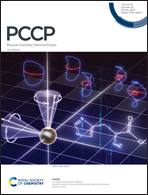Interaction between carbon dots from folic acid and their cellular receptor: a qualitative physicochemical approach†
Abstract
According to the World Health Organization, the number of cancers (all cancers, both sexes, all ages and worldwide) in 2020 reached a total of 19 292 789 new cases leading to 9 958 133 deaths during the same period. Many cancers could be cured if detected early. Preventing cancer and detecting it early are two essential strategies for controlling this pathology. For this purpose, several strategies have been described for imaging cancer cells. One of them is based on the use of carbon nanoparticles called carbon dots, tools of physical chemistry. The literature describes that cancer cells can be imaged using carbon dots obtained from folic acid and that the in cellulo observed photoluminescence probably results from the interaction of these nanoparticles with the folic acid-receptor, a cell surface protein overexpressed in many malignant cells. However, this interaction has never been directly demonstrated yet. We investigated it, for the first time, using (i) freshly synthesized and fully characterized carbon dots, (ii) folate binding protein, a folic acid-receptor model protein and (iii) fluorescence spectroscopy and isothermal titration calorimetry, two powerful methods for detecting molecular interactions. Our results even highlight a selective interaction between these carbon made nano-objects and their biological target.



 Please wait while we load your content...
Please wait while we load your content...